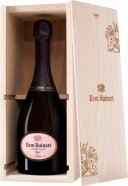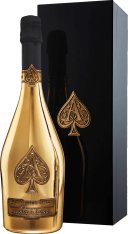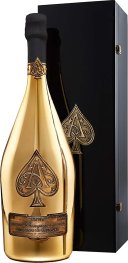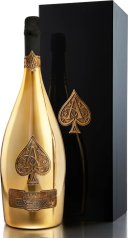Dom Ruinart Rose
The House of Ruinart stands in a league of its own, defying convention and captivating with its unique legacy. Founded in 1729, it holds the distinction of being the very first Champagne House, a visionary endeavour inspired by the foresight of a monk who possessed a remarkable intuition far beyond his era. In the heart of the Champagne region, specifically in Reims, a significant moment unfolded on September 1st, 1729. It was then that Nicolas Ruinart, driven by the profound influence of his visionary monk uncle, drafted the historic charter that marked the birth of Maison Ruinart, forever etching its name as the world's pioneer in champagne production. Little did they know that this bold initiative would pave the way for an enduring enterprise that thrives and prospers even after nearly three centuries, leaving an indelible mark on the course of history. During the remarkable period of the mid-18th century, Ruinart made a significant acquisition to enhance its champagne production. The House secured ownership of ancient crayères, subterranean chalk quarries meticulously carved beneath the historic city of Reims. These extraordinary caverns served as the ideal sanctuary for storing their precious bottles, ensuring optimal aging and maturation. Building upon its reputation for innovation, Ruinart continued to push boundaries. In 1764, the House achieved yet another milestone by successfully shipping the first-ever Rosé champagne across the vast expanse of Europe. This ground-breaking achievement introduced a new dimension to the world of champagne, captivating connoisseurs with its captivating hues and captivating flavors. Bestowed with nobility and adopting the esteemed name Ruinart de Brimont in 1817, the family has diligently guided the House for over two centuries. With each passing generation, a new Head of House emerges, bringing forth their unique talents and unwavering commitment to serve the lineage of Ruinart. This steadfast succession ensures the preservation of the family's legacy, as each successor devotes themselves to upholding the traditions and values that define Ruinart. Their collective efforts have propelled the House to unparalleled heights, solidifying its reputation as a bastion of excellence in the world of champagne. The rosé prestige cuvée of Champagne Ruinart, Dom Ruinart Rosé is a Grand Cru only blend of Dom Ruinart Chardonnay topped off with 15% red wine from the Montagne de Reims. Since the first vintage in 1966, this cuvée is consistently ranked amongst the greatest rosés on the market. The Pinot Noir red wine is sourced from the Grand Cru villages of Sillery and Verzenay and macerated on the skins for nine days before pressing, extracting the pink colour and soft fruit tannins. Blending this red wine into the assemblage gives a rosé with a vibrant, deep coral colour. Dom Ruinart Rosé 2009 is composed of 85% Grand Cru chardonnays, predominantly from the Côte des Blancs (Cramant, Avize, Chouilly, and Mesnil-sur-Oger), the Montagne de Reims (Sillery), and 15% Aÿ Grand Cru pinot noirs. In 2009, hail, rain, and wind disrupted the flowering process but were soon replaced by a dry summer. These summer conditions allowed for the perfect maturation of the grapes until the mid-September harvest. The average sunshine, combined with cool temperatures, enhanced the fruit's aroma while preserving the right acidity sought after by the Maison. Dom Ruinart Rosé 2009 reveals a delicate pink colour with raspberry highlights. The first nose reveal spicy notes of cinnamon, nutmeg and ginger, which mingle with refreshing citrus aromas such as blood orange and kumquat. Second impressions are more floral, unveiling violet and peony complemented by fresh, iodised oyster shell notes. The attack is enveloping and silky with notes of tangy red fruits such as pomegranate and redcurrant. The mid-palate is smooth and saline. Firm and intense, the finish is supported by a delicate bitterness and a fine effervescence. Drink now to 2032+
Laurent-Perrier La Cuvée Brut Non-Vintage
The origin of the House dates back to 1812, created by André Michel Pierlot, it will take the name of Veuve Laurent-Perrier when Mathilde Emilie Perrier, widow of Eugène Laurent decides to combine the two family names while she ensures the development. Eugénie Hortense Laurent, his daughter, inherited the House in 1925 and sold it to Marie-Louise de Nonancourt, née Lanson, in 1939. Laurent Perrier La Cuvée comes from the purest grape juice and it alone allows Laurent-Perrier to craft La Cuvée, a champagne of great finesse and a beautiful freshness obtained after a long ageing process in our cellars. Laurent-Perrier’s style and personality are defined by its very high proportion of Chardonnay. Purity, freshness and elegance – essential characteristics, expressed in this champagne – are a good introduction to the spirit of the House.
Laurent-Perrier Grand Siecle Nº23 Champagne
Grand Siècle is a Prestige Cuvée that is a unique concept, different from the others. It is the only Cuvée de Prestige in Champagne based on the blend and not on the vintage. The vintage in Champagne is generally considered synonymous with excellence for Prestige Cuvées. Conversely, at Laurent-Perrier, their belief is that the art of blending can allow them to create what nature will never give us: the perfect year. The expression of the perfect year is that of a great Champagne wine that has developed a deep intensity and aromatic complexity, while managing to preserve its freshness and acidity over time. On this idea Grand Siècle was born in 1959. To create this wine, Laurent-Perrier will rely on the characteristics of the great vintage years of Champagne: freshness, structure, finesse. Intense pale yellow colour with an intense nose with mixed aromas of candied citrus fruit, honey, summer flowers and a few toasted notes. The soft attack on the palate coats it with the sensation of silkiness. The finish has the freshness of candied citrus fruit bringing with it length and tension.
Armand de Brignac Ace of Spades Brut
The first release from Champagne Armand de Brignac, the Brut Gold remains the most iconic cuvée in the range. Rich with the old-world tradition of champagne blending, it is a trio of vintages from some of the most lauded terroirs of the region, resulting in a cuvée expressing vibrant and fresh fruit character with a soft texture. The striking gold bottle design and unquestionable quality of the Ace of Spades champagne makes it an exceptional bottle of champagne. A marvellously complex and full bodied champagne with a smooth and lengthy finish. A perfectly balanced blend of Chardonnay, Pinot Noir and Pinot Meunier wine. Aromas of apricot, peach, and red berry are followed by crystalized citrus, hints of brioche, and orange blossom. The palate is rich with cherries, exotic fruits and a touch of honey, lemon, and vanilla. The mouth feel is creamy and soft, with a hint of toastiness, from the unique Armand de Brignac dosage which is aged for one year in French oak barrels.
Pommery Brut Royal Non-Vintage Jeroboam
Established in 1836, Madame Pommery is credited with creating the first vintage ‘brut’ style of Champagne in 1874, at a time when most champagnes were excessively sweetened with sugar. This revolutionary dry style set the benchmark for the rest of Champagne and it is in this spirit that the style of Pommery endures; with each cuvée displaying sublime elegance, finesse and freshness. Brut Royal NV has incredible balance and is a cheerful, lively and delicate wine.Pommery is one of the few Champagne houses that produce the large formats in their original bottles, to allow for optimal ageing. The Jeroboam comes individually packed in a timber case.
Moet & Chandon Collection Imperiale Creation No 1
Bollinger Special Cuvée Brut Non-Vintage (6 )
The Maker: For almost two hundred years, Champagne Bollinger has been making powerful, refined and complex wines that express the aromas of fruit in all its dimensions. In 1829, Athanase de Villermont’s vast estate just outside the town of Äy provided the backdrop for the founding of an extraordinary Champagne house - but as an aristocrat, Athanese was forbidden from engaging in commercial trade. With the recruitment of Joseph “Jacques” Bollinger, a Champagne merchant, and Paul Renaudin, a Champernois fascinated by the world of wine, the Bollinger legacy began. The Bollinger style is inimitable and recognised as such by great connoisseurs. It possesses a dense and subtle presence: a balance of the intensity of great Pinot Noirs and the freshness of Chardonnays from the Côte des Blancs. The house’s offerings are rooted in 5 tangible principles: the vineyards; Pinot Noir; magnums of reserve wines; the barrels, and time. Bollinger wines release a creamy effervescence resulting from vinifying in oak barrels and prolonged contact with the yeasts. Every tasting yields new delights that are guaranteed to transport you. The Vineyard: Bollinger has built its vineyards at the heart of the finest crus in Champagne. 180 hectares of vines are made up of 85% Grand and Premier crus and are farmed by our teams of growers across 7 separate vineyards: Aÿ, Avenay, Tauxières, Louvois and Verzenay for Pinot Noir; the Montagne de Reims, Cuis for Chardonnay; and the Côte des Blancs and Champvoisy for Meunier. Another of Bollinger’s distinctive features are the two plots of Clos Saint-Jacques and Chaudes Terres. There, ungrafted vines are entirely tended by hand and reproduced using a form of layering called provignage, preserving the extraordinary heritage from which the Vieilles Vignes Françaises cuvée is produced. Pinot Noir is the varietal on which Bollinger has staked its reputation. A demanding grape that requires care at every step, it remains front and centre because of the incomparable finesse it brings to a wine. Today, the Pinot Noir planted around the Montagne de Reims represents over 60% of the Bollinger vineyards. This also just happens to be the exact proportion it occupies in Special Cuvée! Multi-faceted and surprising, its unusually high ratio in the blends is a signature of the Bollinger style, to which it lends power, body and vinosity. It has been one of the founding principles of Champagne Bollinger’s identity from the very beginning. Bollinger is guided by a responsibility anchored in time and a commitment to people, the earth and our roots. It is committed to the well-being of its teams, preserving biodiversity, and reducing the brand’s carbon footprint. Tasting Notes: NOSE Powerful, complex, red fruits The beauty of ripe fruit and spicy aromas; hints of roasted apples, compote and peaches. PALATE Lush, enveloping, creamy A subtle combination of structure, length and vivacity; bubbles like velvet; pear, brioche and spicy aromas, notes of fresh walnut. FINISH Dry, mineral, petrichor Mellow and refreshing, punctuated by a crisp bite derived from its Chardonnay component. Reviews + Accolades: “... this iconic non-vintage cuvée is dominated by Pinot Noir that gives impressive richness as well as ripe stone fruits. Wood fermentation adds further complexity as does the age of this bottling before release. Drink this Champagne now.” – Wine Enthusiast The Finer Details: Style - Champagne Varietal - Pinot Noir, Chardonnay, Pinot Meunier Country - France Region - Champagne Vintage - Non-Vintage Bottle Size - 750ml ABV - 12% Closure - Cork
Krug Edition 27 Echoes Rose
Besserat de Bellefon Cuvee BB 1843 Champagne Pinot Noir, Chardonnay & Pinot Meunier
Discover a refined bouquet of subtle red berry hints, mingled with notes of warm pastry and fresh ginger. The palate is generously proportioned, showcasing a harmonious blend of crisp fruit, a creamy, almost mousse-like texture, and a refined mineral backbone, culminating in a complex and beautifully balanced taste experience.











